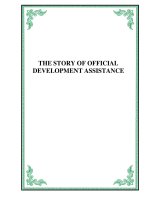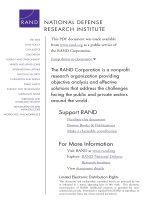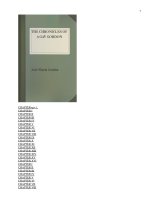The Cost of Capitalism Market Madness_5 ppt
Bạn đang xem bản rút gọn của tài liệu. Xem và tải ngay bản đầy đủ của tài liệu tại đây (266.54 KB, 28 trang )
ended any hope of a simple short-circuiting of the adverse feedback
loop that gripped the housing market (see Figure 11.2).
Why did mortgage rates rise during the aggressive Fed ease? Initial
mainstream commentary tied the rising mortgage rates to fears of
future inflation and the weakness of the U.S. dollar, brought about
when the Fed eased and the ECB stood firm. But that explanation
died in mid-2008. At that time, confidence in the ECB evaporated,
and the European currency plunged. And commodity prices began
their free fall. How could mortgage rates rise amidst a soaring dollar
and disappearing worries about inflation?
Simple. The rise reflected the wholesale collapse of confidence
in the entire mortgage finance industry. As Bernanke, a master of
understatement, put it in late October 2008:
146 • T
HE
C
OST OF
C
APITALISM
Figure 11.2
DNOSAJJMAMF
J
DNOSAJJMAMF
J
20082007
8
6
4
2
0
Rate (%)
Bernanke’s Calamity: The Fed Lowers
the Funds Rate but Mortgage Rates Rise!
U.S. Home Mortgage 30-Year Jumbo vs. Federal Funds Target Rate
30-Year Jumbo Rate
Fed Funds Target Rate
The financial crisis has upset the linkage between mortgage bor-
rowers and capital markets and has revealed a number of impor-
tant problems in our system of mortgage finance. . . .
3
For Minsky, the phenomenon of rising long rates alongside falling
short rates was hardly novel. And the dynamic, in short order,
depressed the real economy. In a crisis, Minsky wrote:
All of the internally generated funds are utilized to repay debt.
A major objective of business, bankers, and financial intermedi-
aries in this situation is to clean up their balance sheets. [This]
can tend to sustain, and may even raise long-term interest rates
even as short-term interest rates are decreasing.
We are no longer in a boom; we are in a debt deflation pro-
cess [as] a feedback from the purely financial developments . . .
[to the real economy] . . . takes place.
4
The mad dash to reduce risk exposure, the dominolike falls of finan-
cial service companies, and the morphing of the U.S. recession into a
global capital markets crisis and a worldwide recession are the subject
of the next chapter.
Bernanke’s Calamity and the Onset of U.S. Recession • 147
This page intentionally left blank
• 149 •
Chapter 12
DOMINO DEFAULTS, GLOBAL
MARKETS CRISIS, AND END
OF THE GREAT MODERATION
You’re nothing but a pack of cards.
—Lewis Carroll, Alice’s Adventures in Wonderland, 1865
W
e are all connected—most especially at Minsky moments. The
chain of events that took the world from a spate of U.S.
subprime lending defaults to a global capital markets crisis will be the
subject of many books. What follows here is my bare description of
the essential elements.
Once subprime borrower defaults began to drive home prices
lower, the jig was up on the world’s greatest Ponzi scheme, and it
was only a matter of time until financial service companies of all
kinds came under pressure. Combine a major episode of failed
Ponzi finance with a moment’s worth of misguided enthusiasm for
Schumpeter’s creative destruction, and you have a recipe for global
capital markets mayhem. We witnessed both in 2008, and the
biggest financial markets crisis since the 1930s took hold as the year
came to a close.
As I noted in the last chapter, rapidly falling home prices started the
destruction by blowing up all the estimates of the value of previously
issued mortgages. Wall Street firms in the business of slicing and dicing
mortgages were knee deep in questionable mortgage products. Not
surprisingly, this deterioration caused their stock prices to plunge and
their borrowing costs to jump. No one was panicking, but that was
because they did not see what lay ahead.
Mortgage availability also tightened as the ultimate holders of
mortgage products began to get queasy about extending home buyers any
more credit. Banks, insurance companies, mutual funds, hedge funds,
and even government-backed mortgage agencies stepped back. New
home buyers soon discovered it was getting harder to qualify for a mort-
gage. By the middle of 2007, subprime lending had just about stopped,
but prime borrowers could qualify for mortgages of less than a million.
By the spring of 2008, the only buyers who qualified were those who
didn’t really need a mortgage, and even they had to pay a higher rate.
It doesn’t require much training in finance to see that the elements
of a housing disaster were in place. Supply was rising because houses
that had previously been started were hitting the market alongside bank
sales of foreclosed homes. Demand was falling as a consequence of
tightening mortgage availability and higher borrowing costs. With
increasing supply and declining demand, prices can only fall. And they
did. Given the inflated level of house prices, it wouldn’t have taken
much to get prices moving downward, and this was more than not
much. By spring 2008 house price declines of a magnitude Wall Street
rocket scientists had dismissed as impossible became the reality. Falling
values caused whatever prospective buyers who still remained to back
150 • T
HE
C
OST OF
C
APITALISM
away, so prices fell faster. Meanwhile, the value of paper secured by
mortgages collapsed, and within a year securities that had a face value
upon issuance of nearly $2 trillion had a market value closer to $1 tril-
lion, if there was any market at all.
A brutal housing recession took hold and soon spread. U.S.
consumers discovered that their access to easy cash through mortgages
and home equity loans was gone. They stopped spending, and as 2007
came to a close, the country entered recession.
Lehman’s Fall, Panic in Corporate Bonds,
and a Global Capital Markets Crisis
The arrival of recession, a consequence of a burst bubble that fostered
investment excesses, described every U.S. downturn since the mid-
1980s. Failed financial institutions are always a part of the crisis in
Minsky’s framework. But the 2008-2009 downturn was different. For
the first time since the 1930s, the creditworthiness of the world’s
banking system—not just individual banks—was called into question.
Ordinary business in the world of finance depends upon the shared
belief that parties to any transaction will hold up their end of any
bargain. “I’m good for the money” is an implicit notion in day-to-day
dealings. Once you lose confidence in the soundness of the people on
the other side of the table, financial business comes to a screeching
halt, and the global economy is not far behind.
Bear Stearns
Appropriately enough, the first firm to fail was Bear Stearns, the then-
reigning world champion at slicing and dicing mortgages. Bear had
Domino Defaults, Global Markets Crisis • 151
for years earned fortunes by gathering mortgages from shaky borrow-
ers and mixing them into cocktails, a remarkable number of which
came out with triple A ratings. By the spring of 2008 it became clear
that Bear just had too much mortgage paper on its own balance sheet,
and with values falling daily, the firm simply ran out of capital. Other
firms refused to do business with it, and the Federal Reserve and the
Treasury then stepped in and arranged a merger with JPMorgan
Chase.
The Treasury/Federal Reserve strategy in dealing with the Bear
Stearns insolvency was consistent with Minsky’s sense of the cost of cap-
italism. As this book makes clear, periodic financial market mayhem
comes with the territory in a capitalist system. It is government’s role
to prevent systemic failure, and in so doing, to prevent the reappear-
ance of an economic depression. Governments need to understand the
difference between creative destruction and deflationary destruction.
Looked upon in that light, the Bear Stearns deal was intelligently
designed.
The terms of the agreement seemed to represent a good balance
between the need to protect the system and the need to punish the
excessive risk takers. The stockholders in Bear Stearns were more or less
wiped out.
1
All employee contracts were abrogated, and employees were
laid off en masse. No bonuses were paid, and many employees who had
received prior bonuses in the form of company stock watched many
years of back pay all but disappear. No one watching the collapse at Bear
Stearns missed the point. Bear had miscalculated and it was paying the
ultimate price.
Nonetheless, Bear did not declare bankruptcy. Thus, the company’s
creditors—the firms and clients to whom Bear owed money—were
protected. And by protecting the thousands of credit links that Bear
152 • T
HE
C
OST OF
C
APITALISM
had with the rest of the financial system, the Treasury/Federal Reserve
plan wiped Bear off the map and yet minimized the adverse conse-
quences to the system.
Lehman Brothers
After Bear’s demise, financial markets stabilized for a short while.
Recessionary forces dissipated for a bit, as tax rebates gave some small
bounce to consumer spending. The seed of doubt, however, had been
planted. If mortgage losses could bring down Bear Stearns, weren’t
there other firms equally vulnerable? Indeed there were, and atten-
tion soon focused upon Lehman Brothers. In the mortgage market,
Lehman had comparable exposure to mortgage finance, though the
firm in its entirety was more diverse. Nevertheless, the same questions
about solvency that undid Bear eventually got to Lehman, and the
firm faced its own crisis.
In this case, however, the Treasury and the Federal Reserve stood
aside. Lehman Brothers exhausted all other options and declared
bankruptcy on September 15, 2008. This meant that investors in
Lehman’s commercial paper and corporate bonds were essentially
wiped out. And in an instant a global bank run was under way.
When Lehman declared bankruptcy, I was shocked.
2
I had been
convinced that government officials understood the gravity of the sit-
uation they faced. I had in fact counseled clients that they could
depend upon the Bear Stearns precedent. If you owned stock in a sus-
pect financial institution, I ventured, you could lose everything if it
failed to quickly turn things around. Thus, a forced merger for
Lehman, with the stock price valued at next to nothing, seemed to be
the clear fate it faced. But the Treasury and the Fed, I was convinced,
Domino Defaults, Global Markets Crisis • 153
recognized the severity of the crisis that would confront them if they
permitted the bankruptcy of a major financial institution.
The Treasury justified its inaction by arguing that, unlike the Bear
situation, Lehman’s failure was not a sudden event, and investors and
other banks had had enough time to insulate themselves from any
damaging exposure to Lehman’s debts. More philosophically, Bush
administration officials let it be known that they wanted to demon-
strate their zeal for the cleansing nature of markets. Lehman had
failed. Anyone tied to its fortunes had to suffer the consequences. It
was misguided faith in free markets and a wildly off-base celebration
of Schumpeter’s creative destruction. To me it was simply dumb-
founding. Within 24 hours the world appreciated just how dumb
it was.
Frozen Credit
By establishing the “Bear precedent,” the government had lessened
worries about lending risks. Once it let Lehman go, those worries
exploded. The example of a financial institution of Lehman’s size and
standing being allowed to fail without compensation to even the hold-
ers of its short-term debts put the financial world into outright panic.
The market for commercial paper, a $1 trillion market by which busi-
nesses finance inventories and working capital, all but closed. Com-
mercial banks became unwilling to lend to one another, much less to
their customers. Money market mutual funds suffered withdrawals of
over $500 billion in a matter of days, and the yields on Treasury bills,
the safest of safe havens, fell below zero!
The Treasury zeal for ideological purity did not survive the week. On
Monday, Lehman was allowed to go bankrupt. On Tuesday, September 16,
154 • T
HE
C
OST OF
C
APITALISM
the Federal Reserve and the Treasury authorized the New York Fed to lend
AIG $85 billion. Thus, their refusal to construct a workout for an invest-
ment bank, in short order, forced them to bail out an insurance company!
The episode’s culminating event took place in early September
when the General Electric Company, one of America’s few remain-
ing triple A enterprises, was forced to sell stock to raise cash because
it was unable to raise money by issuing commercial paper. The mar-
ket, even for G.E., was closed.
It didn’t take long for the world to appreciate the macroeconomic
significance of a frozen credit market. Without access to short-term
credit, any number of companies that operated well outside the
world of finance were placed in jeopardy. That was true of large well-
established companies, but it hit new companies especially hard.
Within weeks, the borrowing rates on high-yield corporate bonds
rose by 5 percentage points or more. All of a sudden ordinary peo-
ple all over the world learned the meaning of the letters CDO.
Collateralized Debt Obligations
Collateralized debt obligations are a market where companies buy and
sell insurance on corporate bonds. Any CDO is a promise between a
buyer and a writer of the insurance. If things go as planned, the buyer
pays the insurer the premium. If things go awry, the insurer pays the
buyer. Either way, one of the two parties gets the money promised in
the transaction. That makes the CDO market, in theory, a zero sum
game.
For the overall financial system, the argument went, there is no
risk, because Harry’s loss will always be Sally’s gain. That logic pre-
vailed, and the market grew without any serious regulatory oversight.
Domino Defaults, Global Markets Crisis • 155
By mid-2007, the CDO market had the implausibly high value of $55
trillion. It amounted to a mountain of wagers about corporate bonds
that dwarfed the value of the underlying securities themselves.
Where was the faulty logic that made this mountain a potentially
crushing burden? What happens if Harry owes Sally and he cannot
pay because he is bankrupt? What if Sally was depending on Harry’s
payment to keep her in good financial stead? She might be forced into
bankruptcy and be unable to honor her CDO payments to Freddy.
Suddenly, in the aftermath of the Lehman bankruptcy, a $55 trillion
market appeared as another rocket science creation that had potential
disaster written all over it. And bank bailouts littered the landscape
over the weeks immediately ahead.
Trying to Squelch a Global Bank Run
Actions speak louder than words. The events of 2007-2008 leave no
room for debate. There is simply no place for free market ideologues in
a banking crisis. The Lehman bankruptcy put that notion to rest in a
heartbeat. I don’t want to overplay the importance of Lehman’s treat-
ment by government officials. It could well be that the system was sim-
ply too ripe for a riot, and the catalyst was incidental. But one thing is
certain. Letting Lehman go on ideological grounds was a complete bust.
Within weeks, Big Government actions were the rule around the globe.
In less than two months the Bush administration did the following:
• Goldman Sachs was converted to a commercial bank from an
investment bank.
• Washington Mutual was seized by federal regulators and melded
into JPMorgan Chase.
156 • T
HE
C
OST OF
C
APITALISM
• The Federal Reserve created the Commercial Paper Funding
Facility.
• Congress approved a $700 billion rescue plan for the banking
system.
• The Treasury forced leading U.S. banks to take a government
infusion of capital.
U.S. actions occurred alongside major steps around the world:
• The U.K. Treasury made $350 billion available for recapitalizing
U.K. banks.
• The Swiss National Bank provided capital to UBS.
• Sweden enacted a $250 billion package to stabilize its financial
sector.
A global banking crisis, requiring broad, sweeping bailouts, and a
deepening worldwide recession are the realities in place as this book
goes to print. How large a price the world will pay for embracing the
notion of market infallibility remains to be seen. But no one should
doubt the fact that the world needs more than new leadership. We
need a new paradigm, one that reflects how the world really works. In
this book’s final chapter I offer up some preliminary thoughts on the
issue of policy, from a global perspective in a postcrisis world. In the
chapter that follows, I sketch out the mainstream economic theory that
informed policy makers in the years leading up to 2008-2009.
Domino Defaults, Global Markets Crisis • 157
This page intentionally left blank
Part IV
RECASTING ECONOMIC
THEORY FOR THE
TWENTY-FIRST CENTURY
This page intentionally left blank
• 161 •
Chapter 13
ECONOMIC ORTHODOXY ON
THE EVE OF THE CRISIS
[Classical] theorists have at their command an impressive array of
proven techniques for modeling systems that ‘always work well’.
Keynesian economists have experience with modeling systems that
‘never work’. But as yet no one has the recipe for modeling systems
that function pretty well most of the time but sometimes work very
badly to coordinate economic activities.
—Axel Leijonhufvud, “Schools, Revolutions, and Research
Programmes in Economic Theory” in Method and Appraisal in
Economics, edited by Spiro Latsis, Cambridge University Press, 1976
A
critical assertion made in this book is that key policy errors
were made that contributed to the 2008 crisis, and that these
errors were strategic not tactical. By that I mean the game plan was
wrong, not its day-to-day operations. Policy, as you would expect,
was a product of today’s conventional economic wisdom. And as
such, mainstream economic theory, and its architects, must accept
some of the blame for the upheaval that came to a climax in
autumn 2008.
Fans of the book Freakonomics will find nothing unsettling about
the criticisms that follow in this chapter. That fantastically popular
economics book uses state-of-the-art microeconomic theory to shed
light on some unusual topics. As the names suggest, micro theory
trains its eyes on particular markets and sectors. Macroeconomics, in
contrast, focuses on economywide issues. How an individual con-
sumer might respond to a sharp rise in gasoline prices is the subject
of micro theory. What consumers, taken together, might do, and what
that would mean for the overall economy, is the subject of macro
theory.
1
In this chapter we train our sights on the current state of
macro theory.
Macroeconomic Fundamentals
There are two essential observations that can be made about
economies. One: over long periods, growth is the rule. Two: with
remarkable regularity, free market economies suffer from boom and
bust cycles.
In simplest terms we can say that macroeconomists who embrace
classical traditions celebrate the “invisible hand” that guides free mar-
kets and produces trajectories like the one depicted in Figure 13.1.
Keynes and his followers concentrated their focus, wondering why
economies, periodically, suffer from bouts of high joblessness, falling
production, and widespread bankruptcies (see Figure 13.2). Paul
Samuelson had this to say about Keynes:
Keynes denies that there is an Invisible Hand channeling the
self-centered action of each individual to the social optimum.
This is the sum and substance of his heresy.
2
162 • T
HE
C
OST OF
C
APITALISM
080604020098969492908886848280787674727068666462605856
20000
10000
8000
6000
4000
2000
In Billions of Chained 2000 $s, Log Scale
Growth Is the Goal
and Growth Is the Rule
NIPA: Real GDP
Figure 13.1
080604020098969492908886848280787674727068666462605856
10
8
6
4
2
0
–2
–4
Year over Year % Change, 2-Quarter Moving Average
Dad’s Dictum: “It’s a Second Derivative World.”
Changes in Growth Rates Animate Economic Opinion.
NIPA: Real GDP
Figure 13.2
What prompted Keynes to break company with the classical econ-
omists of his day? The Great Depression devastated the global econ-
omy. In the United States, unemployment reached 25 percent,
industrial production fell by 40 percent as stocks fell by 90 percent,
and 9,600 banks failed. Everywhere he looked, economic reality was
at odds with the notion of a self-correcting system. Keynes’s revolu-
tionary work, The General Theory of Employment, Interest, and
Money, set in motion a debate that, sadly, seems as unresolved today
as it was in 1936 when his groundbreaking effort made its first
appearance.
Classical economists before Keynes argued that free markets process
information flawlessly and lead economies to healthy places. Keynes
disagreed, and his early admirers built models aimed at sketching out
the role that government should play in tempering periods of falling
activity and overall economic decline. As is true with all great works,
debate raged even among the admirers of Keynes about what the
general theory actually said.
Three groups emerged. Classical economists championed free
market economic traditions and rejected Keynes’s assertions about the
inherent flaws of capitalism. Keynesians cobbled together an amal-
gam of insights from Keynes and classical beliefs, forging what became
known as the “neoclassical synthesis.” And Post-Keynesian economists,
including Hyman Minsky, rejected the neoclassical synthesis, arguing
that much of the genius of Keynes was lost in the attempt to preserve
the lion’s share of the classical economic tradition.
To grossly oversimplify, the groups fared as follows: Keynesians
ruled the roost in the 1950s and 1960s. The 1970s was a battleground.
Monetarists, the first group that refocused on classical traditions, had
a brief heyday in the late seventies and early eighties. The classical
economists of evolving stripes, despite their limited numbers, provided
164 • T
HE
C
OST OF
C
APITALISM
important support for conservative Washington ideologues in the
1980s and into the 1990s.
As we complete this decade, we are in a similar position to the mid-
1970s. The reign of the free market fundamentalists is now clearly
over. Traditional Keynesians, not surprisingly, are clamoring for their
shot at the throne. Many Post-Keynesians see today’s economic plight
as an opportunity to push for radical change. But we need economists
to do better than that.
As I have emphasized throughout this book, we need a new
paradigm to emerge, one that accepts two self-evident truths:
1. Sensibly regulated free market capitalism does the best job of
delivering growth to the citizenry of the world.
2. Financial system excesses are the root cause of many boom and
bust cycles.
The previous 12 chapters, I believe, make it hard to argue with
these two truths. But in the land of academic economics, embracing
these notions will require some heavy lifting:
• Classical economists have to acknowledge that periods of
economic decline reflect flaws in capitalism that justify the
visible hand of government intervention.
• Both classical and Keynesian economists have to accept that
these flaws arise in the world of finance, and that they reflect the
uncertain and at times emotion-filled world we live in.
• And Post-Keynesians, giddy in the knowledge that they have
cracked the code, need to come to terms with the fact that, flaws
and all, free market capitalism is vastly superior to government-
directed investment strategies.
Economic Orthodoxy on the Eve of the Crisis • 165
The rest of this chapter will deal with the views of classical and main-
stream Keynesian economists. The chapter that follows is devoted to
Minsky and the post-Keynesians. I am the most critical of new classi-
cal economics, because in its final form it is close to nonsensical. But
the New Keynesians need to amend their theories. For both groups,
the persistence of certain economic realities can no longer be ignored.
From a Great Monetarist Victory
to an Implausible Theory
Unfortunately for economic policy makers and for the world at large,
economists after Keynes have fought the same fight in different guises,
generation by generation. Once scientists established that the earth
revolved around the sun, the Ptolemaic system was permanently made
obsolete. No one stood up 50 years later with new research aimed at
reestablishing that the sun revolved around the earth. Not so in macro-
economics. Belief in the infallibility of markets, by the mid-1980s,
reemerged as real business cycle theory, only 50 years after the Great
Depression.
How did economic theory wind its way back to belief in infallible
markets? Unquestionably, Keynesians opened the door for a reemer-
gence of classical economic thinking because they overpromised. In the
early 1960s, Keynesians asserted that they had developed monetary and
fiscal policy tools that would allow them to “fine-tune” the economy
and eliminate the boom and bust cycle. By the mid-1970s, amidst soar-
ing inflation and a deep recession, confidence in fine-tuning policies
collapsed.
Economists who championed free market solutions correctly
declared that Keynesians had overreached. Led by Milton Friedman,
166 • T
HE
C
OST OF
C
APITALISM
they asserted that monetary policy should be conducted with only one
focus—controlling the flow of money into the economy. The boom
and bust cycle, they argued, was tolerable. And attempts to eliminate
it, given the limited information policy makers had, only led to higher
inflation and deeper recessions down the road.
3
Friedman’s assessment
carried the day. In 1976 he was awarded the Nobel prize.
Rational expectations became the next cornerstone of conservative
efforts. In simplest terms, the theory says that government attempts to
steer the economy are doomed to failure, because people will see
through the government policies. If the government enacts a spending
program—for instance, to create jobs—people know that it will
require big borrowing. They will sell bonds, correctly anticipating a
surge in government bond issuance. If enough people sell bonds, the
prices fall. And when prices fall, yields rise. So simply the fear of big
budget deficits to come drives interest rates up, and the benefit of more
jobs from the stimulus program is completely wiped out by the lost
jobs that result from higher long-term rates. According to this line of
thought, people are too smart to be fooled by these government efforts
to improve the economy in the short run. They are rational, and as
policies are put in place, they will change their expectations about the
future and thereby thwart the government’s plans.
The rational expectations conclusion? Better to keep government
very small, keep the Fed focused on delivering low inflation, and let
the markets and the private sector deliver the jobs and economic
growth as best they can.
In 1979, President Jimmy Carter appointed Paul Volcker the new
head of the U.S. Federal Reserve Board. Volcker adopted a strategy
long championed by Friedman. He declared that he would ignore
interest rate changes and conduct monetary policy by controlling
Economic Orthodoxy on the Eve of the Crisis • 167
growth in the money supply. Most important, because the Fed asserted
that it was targeting money growth, it was able to claim that it was not
directly responsible for rapidly rising interest rates. And because the
Fed was committed to driving inflation lower, rational expectations
enthusiasts argued that the fall in inflation would not necessarily
require severe economic distress.
The policy worked, but not through any painless change in attitudes.
Instead, inflation was driven lower by crushing economic activity. In
the second quarter of 1980, real GDP fell at a whopping 7.8 percent
annualized rate. More incredibly, real GDP, in the fourth quarter of
1982 was virtually at the same level as in the last quarter of 1978.
Unemployment, at 5.8 percent when Volcker was installed as chair-
man, climbed to 10.8 percent by late 1982. Thus, the Volcker war
against inflation had required back-to-back recessions and resulted in
no growth over four full years! But it did the trick. Inflation fell sharply,
from over 13 percent in 1979 to under 4 percent by early 1983. The
battle had been won.
4
Thus, conservative economic thinking delivered the world a
great triumph. Nothing succeeds like success. And in academia, in
Washington, and on Main Street, conservative economic thinking was
on the rise.
From Invisible to Infallible Hand: New Classical
Economics and Real Business Cycles
Friedman’s victory over fine-tuning changed the way people thought
about the U.S. Federal Reserve Board and about central banks
around the world. Monetary policy was deemed to be responsible
for keeping inflation low. Low inflation, in turn, was thought to offer
168 • T
HE
C
OST OF
C
APITALISM
a market-driven economy its best chance for healthy economic
growth over the long haul.
The Reagan revolution complemented the monetary policy over-
haul. Government programs, regulations, and taxes were slashed. It was
a counterrevolution, effectively dismantling much of the government
infrastructure that had been justified on Keynesian interventionist
grounds.
5
It was a simple message and it carried the day. Monetary policy
would keep inflation low. Private initiative, stripped of government
encumbrances, would propel the economy.
What about recessions, with the big rise for unemployment that is
the earmark of a period of economic decline? Didn’t Fed policy
makers still need to be willing to come to the economy’s rescue during
a contraction? Keynesian theorists, although now on the defensive,
remained adamant that a recession was Exhibit A for anyone needing
evidence that, with some regularity, free markets fail to get us where
we need to go.
Think for a moment about the labor market. Workers supply labor.
Employers demand labor. The price of labor is how much people get
paid. Wage rates shift, standard micro theory tells us, until the number
of people who want to work at that wage level just equals the number
of employers who will hire people at that wage rate. We then have that
magical circumstance for economists, equilibrium.
If you study recessions, however, you start to get queasy about labor
markets and equilibrium. What happens, quite regularly, is that wage
rates don’t fall. Instead, more and more people get fired, and unem-
ployment climbs, in many cases for over a year.
As we will detail in the section that follows, the fact that wage rates
don’t fall during recessions remained a key piece of the New Keynesian
Economic Orthodoxy on the Eve of the Crisis • 169
framework. But conservative economists were hell-bent on champi-
oning free markets at any and all times.
Why such adamancy about the dangers of government intervention?
The battle among policy makers was for very high stakes. Are there
times when the government needs to take direct action to ensure that
the economy gives as much to its citizens as it can? Can we justify
building roads and bridges on the basis of the fact that people need jobs
and the economy isn’t providing them? Can we tell the Fed to stimu-
late the economy by lowering interest rates and printing more money,
because we view a period of high unemployment as unacceptable?
Over the early postwar years, the answer to all of these questions
was always a resounding YES. The Great Depression haunted the
World War II generation, and government policy makers, when
confronting a weak economy, had Keynesian theory and the backing
of the majority as they consistently intervened. Tax cuts, spending
increases, and big ease from the Fed all were employed, to substantial
excess, when the economy disappointed.
But the legacy of freewheeling government meddling, with
Keynesian justification, was the Great Inflation of the 1960s and
1970s. The descendants of Milton Friedman had a victory in hand.
And they were desperate for a rationale that would allow them to assert
that at all times the visible hand of government help was a bad idea.
Dr. Pangloss Discovers Real Business Cycles
Monetary policy debates between Keynesians and classical economists
can be reduced to discussions of rules versus discretion. Economists of
classical descent want central banks to follow an unwavering script.
Monetary policy makers, when they have wiggle room, make matters
170 • T
HE
C
OST OF
C
APITALISM









